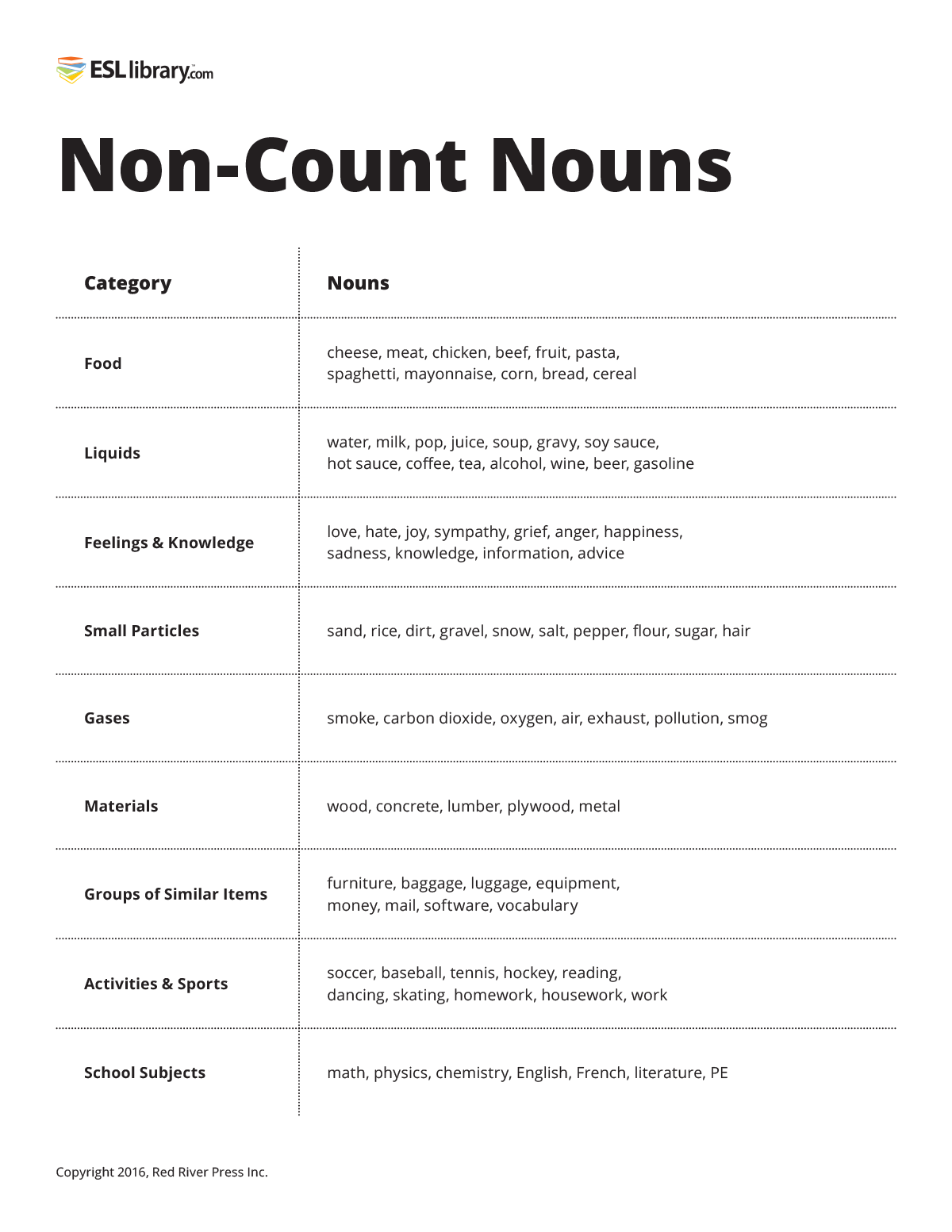Share this post
Early on, English students learn that plural nouns end in -s and singular nouns need an article such as a, an, or the. When students realize that some nouns (e.g., collective, mass, abstract, etc.) don’t end in -s or don’t need an article, they are understandably worried about how to recognize these types of nouns. Giving students a list of categories of uncountable nouns can ease their minds and help them remember when to use articles or add -s. Scroll down for a handy list and teaching tips!
Count Nouns
Count (or countable) nouns are people, places, or things that you can easily number (e.g., one apple, two apples). Singular and plural count nouns follow common rules. Singular count nouns are preceded by an article (a/an/the), a quantifier, a possessive adjective, or a number and are followed by a singular verb, while plural count nouns take the (never a or an), a quantifier, a possessive pronoun, a number, or no article and a plural verb.
- A friend is a gift.
- Two friends are better than one.
- The car in the driveway has pink tires.
- Dogs enjoy going for walks.
Non-Count Nouns
Non-count (or uncountable) nouns are things you can’t count because they’re abstract (i.e., you can’t see them), part of a group, or too small to count. Non-count nouns follow specific rules. They never use a number or a general article such as a or an (though they can be preceded by a specific determiner such as the, a quantifier, or a possessive adjective), never end in -s, and must be followed by a singular verb.
- Rice is part of most Japanese meals.
- Faith gives people hope.
- The snow was piled high this morning.
- My furniture looks dusty.
Categories of Non-Count Nouns
Grammar & Usage Resources – Non‑Count Nouns
Exceptions
Certain non‑count nouns end in -s, such as news or school subjects (physics, mathematics), but they still follow most of the rules for non‑count nouns. They are never preceded by a number or a/an, and they must be followed by a singular verb. Remind students that we can’t count these words (we can’t say one new, two news or one physic, two physics).
- The news brings information to people all over the world.
- Physics is a difficult subject.
Practice
Put these tips and chart to the test in our Grammar Practice Worksheets lesson on Count & Non‑Count Nouns.
Comments (9)
Anonymous A.(Teacher)
April 4, 2016 at 2:42 pm

Tanya Trusler(Author)
April 4, 2016 at 11:51 pm
akash (Guest)
May 2, 2017 at 9:32 pm

Tanya Trusler(Author)
May 2, 2017 at 9:44 pm
Jeannie R.(Teacher)
January 5, 2022 at 1:22 pm

Tanya Trusler(Author)
January 5, 2022 at 10:19 pm
Jeannie R.(Teacher)
January 5, 2022 at 1:24 pm

Tanya Trusler(Author)
January 5, 2022 at 10:20 pm
Nationalities Esl N.(Teacher)
July 19, 2023 at 12:23 am

Tanya Trusler(Author)
July 19, 2023 at 7:28 pm
Teacher B.(Teacher)
October 24, 2023 at 8:44 pm

Tanya Trusler(Author)
October 25, 2023 at 7:23 pm
Yusra M.(Teacher)
April 27, 2025 at 4:29 am

Tanya Trusler(Author)
April 28, 2025 at 5:36 pm
Stephanie Y.(Teacher)
January 6, 2026 at 12:26 am

Tanya Trusler(Author)
January 6, 2026 at 1:30 am

Tara Benwell(Author)
January 6, 2026 at 3:02 pm

Tanya Trusler(Author)
January 6, 2026 at 5:34 pm

